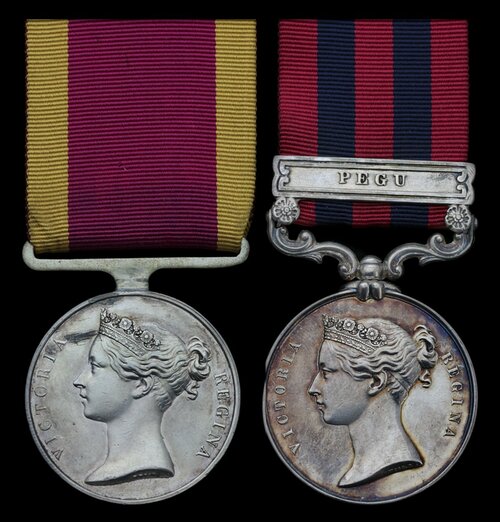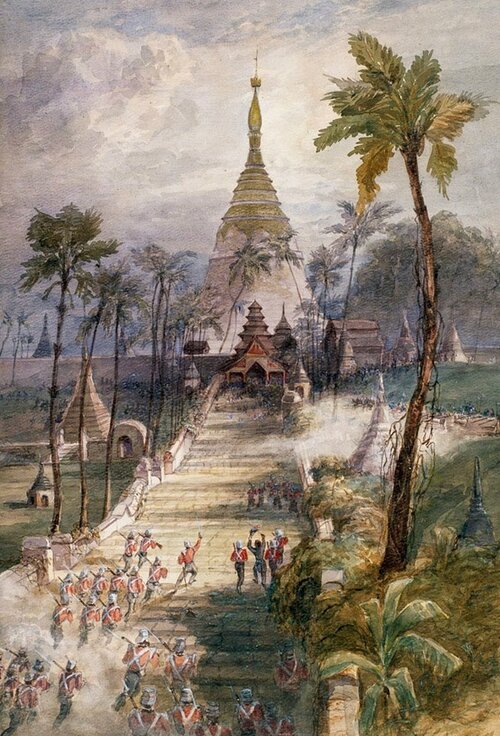Auction: 21003 - Orders, Decorations and Medals
Lot: 285
Pair: Captain I. H. Hewitt, 18th (Royal Irish) Regiment of Foot, later 52nd (Oxfordshire) Regiment of Foot
China 1842 (J. [sic] H. Hewitt, Lieut. 18th R. Irish Reg. Infantry); India General Service 1854-95, 1 clasp, Pegu (Captn. Isaac Henry Hewitt. 18th Rl. Irish Regt.), good very fine (2)
Purchased June 1986.
Isaac Henry Hewitt was born on 22 April 1818 at Kinsale, County Cork, second son of Lieutenant-Colonel I. H. Hewitt. His father served with the 85th, 38th and 6th Regiments, also Commanding the 24th Portuguese Regiment in the Peninsular, having been severely wounded at Monte Video.
Young Hewitt purchased his Ensigncy in the 18th Regiment on 12 July 1839 and was promoted Lieutenant on 13 May 1841, serving with distinction with his unit in China. He is noted as having served in the operations, including the actions at Canton, Amoy, Chusan, Chinhoe, Ningpo, Segoan, Chapoo, Shanghai, Woosung and Chin Kiang Foo. In the action at Chin Kiang Foo on 21 July 1842, Hewitt commanded a section of 14 men who went to assist the Grenadier Company who came up against stiff defence by the Tartars. Hewitt and his men faced a hand-to-hand fight, which cost Private McCarthy his thumb whilst fending off an attack on Hewitt (Medal). He participated in the China Donation Batta and was awarded £109.11s.6d and £36.10s.6d paid in 1846.
Having been promoted Captain on 15 March 1853, he latterly served in the campaign in Burma from 1 April 1852-30 June 1853, when the unit served at Moulmein, Rangoon, Prome, on the Tonghoo Pass and at Donobyu. Having secured Moulmein, they were again engaged at Rangoon when they assisted the Bengal Sappers and the Bluejackets get through the thick jungle to get their ladders onto the White House stockade. On 14 April they were faced with the magnificent Shwe-Dagon pagoda. A fiercely protected bastion, the spectacular 14th century pagoda was defended by cannon over its three main tiers, in addition to being protected by a brick and mud rampart. The force chosen to storm the Pagoda comprised a detachment of the 80th, two Companies of the 18th (Royal Irish) Regiment and some troops from 40th Bombay Native Infantry.An approach march having been made before dawn through jungle, the ranks of the storming party readied themselves for the attack. James Jones's History of the South Staffordshire Regiment (1705-1923) takes up the story:
'The distance to be covered in the advance to the eastern entrance of the Pagoda was 800 yards. The troops crossed steadily under a heavy fire from the walls crowded with the enemy. When the storming party reached the Pagoda steps, a rush was made for the upper terrace, and a deafening cheer told that the Pagoda was won. The enemy evacuated the place in great confusion, and were severely handled by the troops and the fire from the steamers on the river.'
They latterly found themselves under siege at Prome in August-October 1852 and in November two Companies were sent out to the districts on patrol to locate enemy. With a force cornered at Tomah, the British waited until March 1853 for reinforcements for a full scale attack, which eventually cost the 18th 1 killed and 28 wounded. The Regiment sent Companies onto the Tonghoo Pass to shepherd a delivery of 148 elephants over the pass. Others were sent out against Myat Toon and were part of the main attack on his stronghold on 19 March, when a frontal attack with the Sikhs secured the victory. Once peace stopped the field operations, the unit was returned to Calcutta, depleted by 365 casualties over the course of the operations.
Hewitt transferred to the 52nd Regiment and retired by sale of his commission in 1856. Having married Fanny Howard, daughter of The Rev. Henry Howard of Quendon, Essex, he died on 3 June 1865; sold together with a file of copied research.
Subject to 20% VAT on Buyer’s Premium. For more information please view Terms and Conditions for Buyers.
Sold for
£2,000
Starting price
£1400







